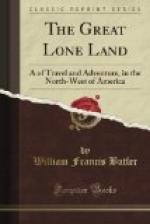It now only remains for me to refer to the last clause in the instructions under which I acted, before entering into an expression of the views which I have formed upon the subject of what appears necessary to be done in the interests of peace and order in the Saskatchewan. The fur trade of the Saskatchewan District has long been in a declining state, great scarcity of the richer descriptions of furs, competition of free traders, and the very heavy expenses incurred in the maintenance of large establishments, have combined to render the district a source of loss to the Hudson Bay Company. This loss has, I believe, varied annually from 2000 to 6000 pounds, but heretofore it has been somewhat counter-balanced by the fact that the Inland Transport Line of the Company was dependent for its supply of provisions upon the buffalo meat, which of late years has only been procurable in the Saskatchewan. Now, however; that buffalo can no longer be procured in numbers, the Upper Saskatchewan becomes more than ever a burden to the Hudson Bay Company; still the abandonment of it by the Company might be attended by more serious loss to the trade than that which is incurred in its retention, Undoubtedly the Saskatchewan, if abandoned by the Hudson Bay Company, would be speedily occupied by traders from the Missouri, who would also tap the trade of the richer fur-producing districts of Lesser Slave Lake and the North. The products-of the Saskatchewan proper principally consists of provisions, including pemmican and dry meat, buffalo robes and leather, linx, cat, and wolf skins. The richer furs; such as otters, minks, beavers, martins, etc., are chiefly procured in the Lesser Slave Lake Division of the Saskatchewan District. With regard to the subject of Free Trade in the Saskatchewan, it is at present conducted upon principles quite different from those existing in Manitoba. The free men or “winterers” are, strictly speaking, free traders, but they dispose of the greater portion of their furs, robes, etc., to the Company. Some, it is true, carry the produce of their trade




